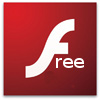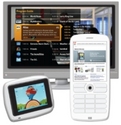Adobe frees Flash for devices
May 1, 2008 — by LinuxDevices Staff — from the LinuxDevices Archive — 1 views Adobe hopes to make its Flash technology as ubiquitous on devices as PCs. Under an “Open Screen Project,” it will remove restrictions on Flash file formats, open Flash server protocols, and give away the player along with the APIs needed to port it to new devices.
Adobe hopes to make its Flash technology as ubiquitous on devices as PCs. Under an “Open Screen Project,” it will remove restrictions on Flash file formats, open Flash server protocols, and give away the player along with the APIs needed to port it to new devices.
 While versions of the Flash Player for desktop operating systems have been free, cell phone manufacturers and other device makers have had to pay a license fee. They won't need to any longer, says Adobe. The current installed base of half a billion mobile devices is expected to double over the next twelve months as a result, the company added — paving the way to increased sales of Adobe's development tools for flash content creators.
While versions of the Flash Player for desktop operating systems have been free, cell phone manufacturers and other device makers have had to pay a license fee. They won't need to any longer, says Adobe. The current installed base of half a billion mobile devices is expected to double over the next twelve months as a result, the company added — paving the way to increased sales of Adobe's development tools for flash content creators.
Specific elements of the Open Screen Project include:
- Removing licensing fees, making new releases of the Adobe Flash Player and AIR (Adobe Integrated Runtime) free
- Removing restrictions on the use of the SWF (shockwave flash) and FLV (flash video) file formats
- Publishing the device-layer APIs (application programming interfaces) for porting Flash to new devices
- Publishing the Flash Cast protocol and AMF (action message format), which let Flash applications receive information from remote databases
Flash uses the SWF binary format to deliver vector graphics, text, video, and sound. The related FLV/F4V media container formats are often used separately by webcasters such as YouTube, Yahoo! Video, and many others. But, while SWF and FLV specifications have been published since 1998, associated license agreements said developers could use this information only to create software that could output the formats. In other words, you could create tools that wrote SWF formats, but were not allowed to create a player. As of today, this limitation has been scrapped, and developers now are free to indulge in SWF playback.
Adobe also said it would publish device porting layer APIs for both the Flash Player and AIR. Described as “device-specific abstractions of the Adobe Flash Player,” these will assist porting Flash onto new platforms.
Finally, Adobe said it has published its AMF (action message format) file format today, and will do the same for its Flash Cast protocol in the next few months. AMF is most commonly used to transfer information from databases to Flash applications, while Flash Cast is used by mobile operators to push data to phones, according to the company.
While undoubtedly welcome to the device building community, Adobe's Open Screen Project does not transform Flash into a truly open-source product, because Flash still contains technologies, such as audio and video codecs, that are licensed from others. In 2006, however, Adobe open-sourced a key ingredient of Flash, the ActionScript scripting engine.
For a truly open-source implementation of Flash, one must investigate Gnash, an SWF player and browser plugin that was released in beta form last month. Glash runs on various versions of Linux, supporting embedded architectures including MIPS, PowerPC, ARM, and Sparc. A Windows port is said to be in progress. Another “clean room” player implementation for Windows is available from Oregan Networks.
Initial Open Screen Project partners cited by Adobe include ARM, Cisco, Intel, Marvell, Motorola, Nokia, and Qualcomm. Notably lacking, however, are Apple, Google, and Microsoft.
Microsoft offers its own Flash-like technology, Silverlight. Supporting animation, vector graphics, and media playback, it was introduced last year for Windows and Macintosh desktops, but is now available in a Windows Mobile version as well. For more information, see coverage on our sister site WindowsForDevices.com, here.
In its announcement of the Open Screen Project, Adobe's press statement said, “A consistent application runtime should be available across desktops and devices, and we have spearheaded a project with the support of industry leaders to work together to deliver on this vision.”
Further information
Adobe's website for the Open Screen Project includes a complete list of supporters, a FAQ, and links to the available SWF, FLV/F4V, and AMF specifications. It can be accessed here.
This article was originally published on LinuxDevices.com and has been donated to the open source community by QuinStreet Inc. Please visit LinuxToday.com for up-to-date news and articles about Linux and open source.